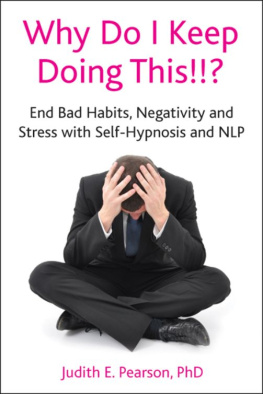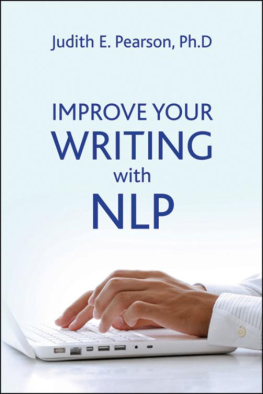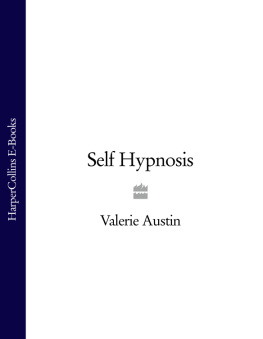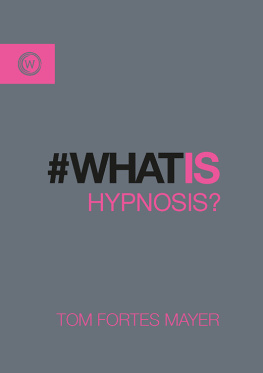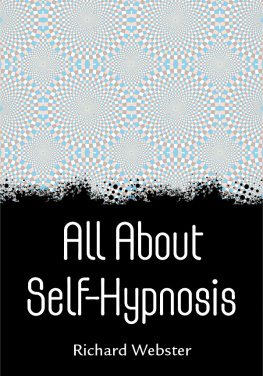I have amnesia for the remainder of the dream but I cant help but remember the varied contents of Judys book, which is nothing less than a remarkable achievement. If a person curious about hypnosis and self-improvement were to seek answers from only one source, it should be this book, which asks all the right questions and provides full and complete answers for one seeking solutions.
Now, learning self-hypnosis is not a magic bullet for, say, alcohol dependence or severe depression. With these and other common clinical disorders the author provides clear and careful explanations of other things the person should consider in addition to learning self-hypnosis. Judy, a seasoned practitioner who knows what shes talking about, makes it clear that some people may require additional psychotherapy and/or clinical hypnosis from a licensed mental health professional. I customarily tell my students, If they show up and walk through the door, theyre obviously interested, and the difficult part is out of the way. Kind reader, you have picked up this book and read up to this point, so you have taken that initial important step. You have entered the room.
The solution to your problem or my problem lies in the unconscious mind, and rest assured, Judy considered the unconscious mind in devising her techniques in this book. The solid writing and copy-editing make this a well-organized book that is easy to read and apply to your personal situation. Hypnotic content in a book allows you to discover and grow long after youve read it. It reminds me of the painter, Ted DeGrazia, who painted those pictures of the little Indians with no faces. When he put the final touches on a painting he said, This painting is complete but it is never finished.
I wish to acknowledge the staff at Crown House Publishing for their help in bringing this book to publication. First, many thanks to the Mark Tracten, the U.S. distributor who alerted me in 2009 that Crown House was open to a proposal for a new book on self-hypnosis. Mark works diligently for Crown House authors in the U.S., not only marketing our books, but serving as a sounding board and as our ear to the ground in the publishing world.
My heartfelt gratitude goes to David Bowman for accepting my book proposal . Through his expert advice and marketing savvy, I simplified and improved on my original concept. I am grateful to David and his associates for their forbearance and patience with my delays in submitting the drafts, due to the demands of my busy work schedule. Additionally, no author could ask for better guidance than that I received from Beverley Randell who gently guided me through the details of copy-edits and permissions.
My appreciation goes to George Gafner, an established author, psychologist , and hypnotherapist who graciously agreed, without hesitation, to write the foreword. I also extend thanks to Bob Bodenhamer, D. Min. for his straightforward advice concerning the length of the first draft. Both of these fine authors shared their own publishing experiences and gave me encouragement.
Lastly, I thank my husband, John, for his unflagging confidence in my writing abilities and for his continuing optimism throughout the production of this book. As an author with a full-time practice, my biggest problem was finding sufficient blocks of time to capture ideas on a computer screen and let my thoughts flow freely, without interruption or distraction. John, an author himself, understood this. He demonstrated unparalleled devotion by taking over several household duties, allowing more time for me to hunker down over the keyboard. Such a sweetheart of a guy!
I am grateful to the following authors who gave permission to quote from and/or adapt material from their publications:
L. Michael Hall, Ph.D. who gave permission to adapt the Neuro-Semantics Meta No/Meta Yes pattern and the Neuro-Semantics Mind-to-Muscle pattern from Secrets of Personal Mastery, Bancyfelin, Wales: Crown House Publishing Ltd., 2000; and the NLP Self-esteem Pattern from the Accessing Personal Genius Training Manual, Clifton, Colorado: Neuro-Semantics Publications, 2000.
Steve Andreas who gave permission to adapt The NLP Slender Eating Strategy and the NLP Responding to Criticism pattern from Heart of the Mind, Boulder, Colorado: Real People Press, 1989.
Carol Goldsmith who gave permission to quote from The Book of Carols, Haverford, Pennsylvania: Infinity Publishing, 2003.
Robert Dilts who gave permission to adapt The Walking Belief Change Pattern from an audio-recording by the same name, by Robert McDonald, Boulder, Colorado: NLP Comprehensive, 1979.
Nick Kemp who gave permission to adapt a submodalities pattern for negative inner dialog, from an electronic newsletter issued by Steve Andreas, 2008.
Jon Connelly, Ph.D. who granted permission to paraphrase a metaphor from his Rapid Trauma Resolution Training Program, conducted at the Institute for Rapid Resolution Therapy, in Tampa, Florida, 2006.
Rue Ann Hass who granted permission to adapt What is Your Soul Dream? from an article by the same name in Anchor Point magazine, Boulder, Colorado, 2003.
Ron Klein, who granted permission to paraphrase a quote from his Ericksonian Hypnosis and Brief, Outcome-Oriented Psychotherapy training courses at the American Hypnosis Training Academy.

